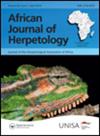Mistaken identity: challenges with specimen identification for morphologically conservative skinks (Trachylepis) leads to taxonomic error
IF 0.9
4区 生物学
Q3 ZOOLOGY
引用次数: 2
Abstract
ABSTRACT It is commonly recognised that natural history datasets contain locality errors that can compromise the utility of those datasets. However, another source of error in these datasets is taxonomic misidentifications, and this type of error is potentially common, particularly with regards to morphologically conservative species. For example, in the African skinks, the Trachylepis striata and T. varia species complexes each contain morphologically similar species that are commonly confused, despite being genetically distinct. Some species also are partly sympatric, and misidentifications are likely to be especially problematic in those areas. Using DNA barcoding, we assessed misidentification rates between species and applied the updated identifications to known distribution maps to examine whether those maps are accurate representations. Existing banked samples and newly collected samples were DNA barcoded using the mitochondrial 16S gene and supplemented with GenBank data. Identifications were made by matching sequences using haplotype networks that included material from near type localities. The barcode-based identifications were compared with the original identifications recorded for those samples. Taxonomic error was common, particularly in areas of presumed sympatry (error for T. striata species complex: 28%; T. varia species complex: 31%) and this resulted in inaccurately represented species distributions and areas of sympatry. Areas of sympatry were, however, confirmed for T. spilogaster/T. punctatissima, T. striata/T. punctatissima and T. damarana/T. laevigata/T. varia. Our findings corroborate other studies that demonstrate taxonomic error in existing datasets is a significant, but typically unrecognised problem, particularly for morphologically conservative species. This has implications for the utility of historical collections, citizen science records and public databases used in the formulation of species distribution maps, but also for other downstream analyses that rely on these datasets.错误的身份:挑战与标本鉴定的形态保守石龙子(石龙目)导致分类错误
人们普遍认为,自然历史数据集包含局部性错误,这可能会损害这些数据集的效用。然而,这些数据集中的另一个错误来源是分类上的错误识别,这种类型的错误可能是常见的,特别是关于形态保守的物种。例如,在非洲石龙子中,尽管遗传上不同,但在形态上相似的石龙子和变种石龙子物种复合体中,每种石龙子都包含了通常被混淆的物种。有些物种也是部分同域的,在这些地区,错误识别可能尤其成问题。利用DNA条形码技术,我们评估了物种之间的误认率,并将更新的鉴定应用于已知的分布图,以检验这些图是否准确表征。使用线粒体16S基因对已有的样本和新收集的样本进行DNA条形码编码,并补充GenBank数据。通过使用单倍型网络匹配序列进行鉴定,其中包括来自近类型位置的材料。将基于条形码的鉴定与这些样品的原始鉴定进行比较。分类学上的错误是常见的,特别是在假定的同属区(纹状体物种复合体的错误:28%;变种弓形虫物种复合体(31%),这导致物种分布和同属区不准确。然而,共感区被证实为溢出型T。斑纹病,斑纹病斑点病和T. damarana/T。laevigata / T。杂物。我们的发现证实了其他研究表明,现有数据集的分类错误是一个重要的,但通常未被认识到的问题,特别是对于形态保守的物种。这不仅影响了历史收集、公民科学记录和公共数据库在制定物种分布图中所使用的效用,也影响了依赖这些数据集的其他下游分析。
本文章由计算机程序翻译,如有差异,请以英文原文为准。
求助全文
约1分钟内获得全文
求助全文
来源期刊

African Journal of Herpetology
ZOOLOGY-
CiteScore
3.00
自引率
6.70%
发文量
15
审稿时长
>12 weeks
期刊介绍:
African Journal of Herpetology (AJH) serves as an outlet for original research on the biology of African amphibians and reptiles. AJH is an interdisciplinary journal that publishes original articles and reviews from diverse fields and disciplines, such as conservation, phylogenetics, evolution, systematics, performance, physiology, ecology, behavioural ecology, ethology, and morphology.
The Journal publishes two issues a year. There are no page charges .
 求助内容:
求助内容: 应助结果提醒方式:
应助结果提醒方式:


